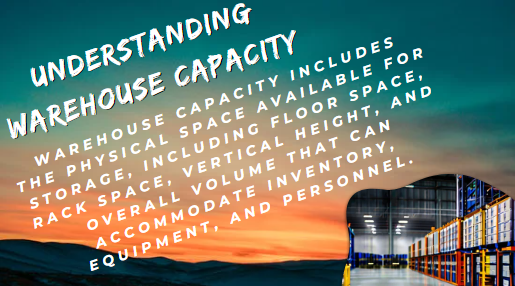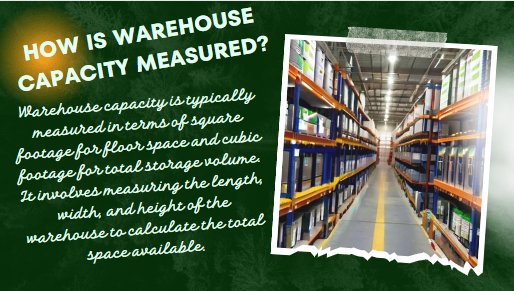Warehouse Capacity act as the backbone of supply chains, playing a vital role in storing, managing, and distributing goods. Warehouse capacity, the measurement of available space and resources within a warehouse, is a key factor in determining the productivity and success of logistics operations. This comprehensive guide highlights warehouse capacity’s ins and outs, importance, optimization strategies, and future trends.
- Understanding Warehouse Capacity
- Optimization of warehouse capacity
- Inventory Management and Slotting
- Technology Integration
- Lean and agile operations
- Challenges in Warehouse Capacity Management
- Future Trends in Warehouse Capacity Management
- Understanding Warehouse Capacity Calculations
- Formulas and calculations
- Importance of accurate capacity calculation
- Challenges and ideas
- Conclusion
- Frequently Asked Questions:
- What is the warehouse capacity?
- How is warehouse capacity measured?
- What factors affect warehouse capacity?
- Why is it important to calculate warehouse capacity?
- How can warehouse capacity be optimized?
- What are the challenges in managing warehouse capacity?
- How can businesses increase warehouse capacity without expanding physical space?
- What role does technology play in optimizing warehouse capacity?
- How does warehouse capacity impact overall logistics and supply chain efficiency?
- What are some common metrics used to assess warehouse capacity utilization?

Understanding Warehouse Capacity
Defining warehouse capacity
Warehouse capacity includes the physical space available for storage, including floor space, rack space, vertical height, and overall volume that can accommodate inventory, equipment, and personnel.
Types of Warehouse Capacity
Storage Capacity:
The maximum amount of inventory that can be held in a warehouse.
Throughput capacity:
Considering receiving, storage, and shipping, the amount of goods a warehouse can handle within a specified time frame.
Factors Affecting Warehouse Capacity
Layout and design:
Warehouse layout, racking systems and space utilization techniques have a significant impact on efficiency.
Inventory variability:
Different shapes, sizes, and types of products affect storage density and picking efficiency.
Operational Processes:
Efficiency in receiving, picking, packing, and shipping processes directly impacts warehouse space utilization.

Optimization of warehouse capacity
Warehouse Layout and Design
Utilization of vertical space: Implementing tall racks and mezzanine floors to maximize vertical storage.
Optimized Aisle and Shelving:
Efficient aisle width and storage configurations maximize accessibility and space utilization.
Inventory Management and Slotting
ABC analysis:
Prioritizing inventory based on its importance or value to optimize its location within the warehouse.
Dynamic slotting:
Constantly reorganizing inventory based on demand patterns to reduce picking time and maximize space utilization.
Technology Integration
Warehouse Management System (WMS):
Using WMS for real-time tracking, inventory visibility, and efficient resource allocation.
Automation and robotics:
Implementing automated systems for picking, packing, and stacking to increase speed and accuracy.
Lean and agile operations
Just-in-Time (JIT) Inventory:
Aligning inventory levels with demand to reduce excess stock and optimize storage space.
Cross-docking:
Transferring goods directly from inbound to outbound without storage reduces the need for warehouse space.

Challenges in Warehouse Capacity Management
Lack of space
Limited space presents challenges in accommodating growing inventory and operational needs.
Seasonal and cyclical demands
Managing fluctuating demands during peak seasons requires dynamic space utilization and resource allocation strategies.
Labor and workflow constraints
Inefficient workflow and inadequate labor optimization affect the speed and efficiency of operations.
Future Trends in Warehouse Capacity Management
Smart Warehousing
Integration of IoT devices, sensors, and AI-powered analytics for real-time monitoring and analytical maintenance.
Continuous storage
Emphasis was placed on eco-friendly practices, energy-efficient designs, and green technologies to reduce the environmental footprint.
Robotics and Automation
Further advancements in robotics and automation to increase efficiency, accuracy, and scalability in warehouse operations.

Understanding Warehouse Capacity Calculations
Measurements and Dimensions
Calculating warehouse capacity starts with an accurate measurement of the available space. This also includes:
Floor space:
Measure the length and width of the warehouse to determine the total square footage.
Vertical Height:
Measure the height from floor to ceiling to determine the cubic footage available for vertical storage.
Calculating the Total Storage Volume
Multiply the dimensions:
Multiply the length, width, and height to get the total storage volume in cubic feet or meters.
Consider usable space:
Pay attention to obstructions such as columns or machinery that may reduce usable space.
Factor in racking systems and aisles
Racking systems:
Determine the space taken up by racks, shelves, or pallets. Calculate the amount they consume and subtract it from the total storage volume.
Aisle space:
Consider the space between racks or shelves needed for the movement of equipment and personnel.
Density and storage configuration
Storage density:
Evaluate different storage configurations (bulk storage, selective racking, and drive-in racking) to optimize space utilization based on inventory characteristics.
Special Considerations:
Consider specific needs such as temperature-controlled areas, hazardous materials storage, or special storage needs that may impact available space.

Formulas and calculations
Calculating Total Warehouse Space
For a simple rectangular warehouse:
Total warehouse space = Length × Width × Height
For irregular shapes or multiple areas:
Divide into sections and calculate the volume of each section separately.
Calculating usable space
Usable space = Total warehouse space – Space taken up by permanent fixtures (racks, columns) – Aisle space
This provides the actual space available for inventory storage.
Determining Storage Density
Storage Density (%) = (Total Inventory Quantity / Usable Space) × 100
This metric indicates how efficiently warehouse space is used.
Importance of accurate capacity calculation
Optimized resource allocation: Accurate capacity calculations allow efficient allocation of resources, including labor, equipment, and storage solutions.
Forecasting and Planning:
It helps to forecast future storage requirements and plan expansion or reconfiguration to accommodate increasing inventory.
Cost Optimization:
By maximizing space utilization, businesses can reduce unnecessary expenses associated with large warehouses or additional facilities.
Challenges and ideas
Dynamic Inventory:
Fluctuating inventory levels and changing product characteristics can affect available space.
Technology integration:
Implementing a warehouse management system (WMS) or automated solutions for accurate inventory tracking impacts storage configuration.
Conclusion
Warehouse capacity management is a complex aspect of logistics that significantly impacts supply chain performance. Maximizing warehouse capacity involves a strategic combination of efficient layout design, advanced technologies, streamlined processes, and adaptable strategies to meet the growing demands of the market. As businesses continue to grow, optimizing warehouse capacity will be critical to improving operational excellence and maintaining a competitive edge in an ever-evolving global marketplace.
Calculating warehouse capacity involves assessing various dimensions, configurations, and space utilization factors to determine the actual usable space for inventory storage. It is a fundamental aspect of warehouse management, important for efficient operations, resource optimization, and future planning. Accurate calculations empower businesses to make informed decisions about space utilization, leading to improved efficiency and cost-effectiveness in warehouse operations.
Click here for more topics.
Frequently Asked Questions:
What is the warehouse capacity?
Warehouse capacity refers to the total amount of space available to store inventory, goods, or materials within a warehouse. This includes both the physical area and the amount of space that can be used for storage.
How is warehouse capacity measured?
Warehouse capacity is typically measured in terms of square footage for floor space and cubic footage for total storage volume. It involves measuring the length, width, and height of the warehouse to calculate the total space available.
What factors affect warehouse capacity?
Many factors affect warehouse capacity, including the warehouse’s physical dimensions, layout and design, types of storage systems used (racks, shelves, bins), aisle width, inventory characteristics (size, shape, weight), and someone’s presence. Fixed structures or machinery.
Why is it important to calculate warehouse capacity?
Calculating warehouse capacity is important for effective inventory management, space optimization, and resource allocation and planning. It helps in determining the maximum amount of inventory that can be kept in a warehouse and ensures efficient utilization of available space.
How can warehouse capacity be optimized?
Optimizing warehouse capacity includes maximizing vertical space with taller racks, implementing efficient storage configurations, using a warehouse management system (WMS) for inventory tracking, employing efficient aisle widths, and regularly maintaining storage density. Strategies include assessing and adjusting.
What are the challenges in managing warehouse capacity?
Challenges include fluctuating inventory levels, seasonal variations in storage requirements, dynamic storage requirements due to changing product characteristics, integrating technology for accurate inventory tracking, and balancing space utilization with operational efficiency.
How can businesses increase warehouse capacity without expanding physical space?
Businesses increase warehouse capacity by implementing efficient storage systems like mezzanine floors, using high-density storage solutions, reorganizing layouts for better space utilization, adopting automation and robotics for compact storage, and implementing dynamic inventory management strategies.
What role does technology play in optimizing warehouse capacity?
Technology such as warehouse management systems (WMS), RFID tracking, barcode scanning, and automated inventory systems play a vital role in optimizing warehouse capacity by providing real-time visibility into inventory, streamlining operations, and improving accuracy in space utilization.
How does warehouse capacity impact overall logistics and supply chain efficiency?
Warehouse capacity directly impacts logistics and supply chain efficiency by affecting inventory handling, order fulfillment speed, storage costs, and the ability to meet customer demand. Optimization of warehouse capacity contributes to smooth logistics operations and increased customer satisfaction.
What are some common metrics used to assess warehouse capacity utilization?
Metrics such as storage density (percentage of space utilized), inventory turnover rates, fill rates, and space utilization ratios are commonly used to assess how effectively warehouse capacity is being utilized and make improvements. Areas are identified for improvement.
